|
Main Menu
|
|
|
|
4Runner History
|
|
|
|
Other
|
|
|
|
|
| 1996 4Runner History: |
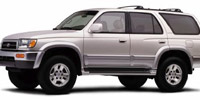
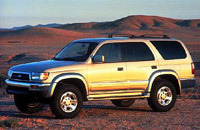
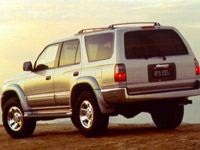
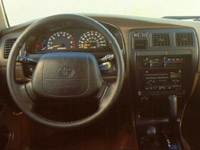
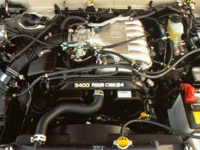
1996 Toyota 4Runner
Limited |
Toyota introduces the third-generation 4Runner.
The 4Runner receives a complete redesign for 1996 which includes all new engines, chassis, interior and exterior styling, enhanced safety equipment and added utility.
It is the first 4Runner to not share either body panels or a frame with Toyota's compact pickup trucks.
Toyota's third generation 4Runner is the first generation that does not share either sheet metal or chassis with
Toyota's compact pickups. It's refined and well-appointed interior allows for greater cargo area and increased
utility while optimizing driver and passenger seating comfort and ride quality.
The '96 4Runner is available in base, SR5 and Limited grades, 2WD and 4WD configurations equipped with either a
five-speed manual or four-speed electronically controlled automatic transmission. A 2.7-liter four-cylinder engine
is standard with a powerful 3.4-liter V6 available on all models except the 2WD five-speed. Both engines produce more
horsepower and torque than those found in the previous generation, while offering improved fuel economy and lower
exhaust emissions.
The 2.7-liter 16-valve double-overhead cam four-cylinder engine develops 150 horsepower an increase of 34 compared
to the previous generation's four-cylinder and equal to the previous generation V6. A four-valve design and long
independent intake runners combine for improved intake efficiency and greater power. A small valve angle and
compact cylinder head with a pent-roof combustion chamber improves combustion efficiency and reduces knocking
tendencies. A large capacity 8.1-liter air cleaner and intake resonator help boost torque at mid-range speeds.
Stainless steel exhaust gas recirculation piping and aluminum alloy crankshaft bearings contribute to improved
engine reliability, while balance shafts account for reduced engine noise and vibration.
The new V6 engine features a double-overhead cam four-valve design which boosts both horsepower and torque.
4Runner's new V6 powerplant kicks horsepower from 150 to 183 and torque from 180 to 217 lb.-ft. Standard towing
capacity of V6 models has increased from 3,500 to 5,000 pounds for both 2WD and 4WD models.
Long independent intake runners provide improved air intake efficiency for greater power. The V6 also utilizes a
large-capacity 9.4-liter air cleaner, and a dual-intake resonator to reduce noise, vibration and harshness (NVH).
Both the V6 and four-cylinder engines comply with OBD II emissions regulations.
The 4Runner's wheelbase is extended a full two-inches longer than the previous generation and has an extended side
rail cross section on the frame. The side rail bending rigidity has been strengthened for improved steering stability
and more precise suspension movement resulting in a more comfortable ride, especially when traveling off-road.
In addition, front dual suspension cross members have been incorporated improving suspension action by strengthening
lateral rigidity during cornering and longitudinal rigidity during braking.
Front suspension on the all-new 4Runner is a coil spring double-wishbone configuration, which replaces the Hi-Trac
torsion bar double wishbone suspension on the previous generation. The lower arm uses a closed cross-sectional
structure that adds strength while reducing unsprung weight. Suspension travel has increased 1.5-inches improving
off-road performance while tread width has been increased by 0.8-inches for enhanced steering stability and ride comfort.
Models equipped with P265 tires utilize stroke-dependent type shock absorbers.
The rear suspension is a new four-link coil-spring type designed specifically for 4Runner. As with the front,
rear suspension travel and tread width has been increased. Rear suspension travel has increased by 1-inch on 2WD
configurations and 1.6-inches on 4WDs, with tread width jumping from 58-inches to 58.9-inches (models with 16-inch
wheels have 59.4-inch). 4Runners equipped with P265 tires utilize rebound spring type shock absorbers to improve
vehicle stability.
A torque control system has been added to the four-speed electronically controlled automatic transmissions (ECT)
in all 4Runner models. When shifting, the torque is momentarily reduced by retarding the engine's ignition timing
to help ensure smooth gear changes. The five-speed manual transmission incorporates a triple-cone synchro for the
second gear and a double-cone synchro for third gear to improve durability. Both transmissions use a reverse gear
synchro to reduce gear noise when shifting into reverse.
A One-Touch Hi-4 switch is standard on the Limited grade. This feature allows for 4WD engagement by pressing a
button on the transfer case selector knob. The transfer lever is still utilized for 4WD High to 4WD Low engagement.
Toyota 4Runner also features an optional Locking Rear Differential with a 4.300 rear differential on all 4WD models.
When the system is engaged, 4Runner's rear wheels receive equal torque, providing maximum power transfer in severe,
poor-traction conditions.
Steering feel and response have been improved in 4Runner by replacing the recirculating ball-type steering with rack
and pinion steering. Rubber mounted bushings are used to attach the steering gearbox to 4Runner's frame optimizing
steering feel and decreasing vibration.
Four-wheel anti-lock brakes (ABS) are standard on all V6 4Runners and optional on those equipped with the four-cylinder
engine. Four-wheel ABS helps prevent wheel lock-up, letting the driver maintain better control during sudden
stops on poor traction surfaces. The ABS computer uses four speed sensors to calculate the wheel speed and
acceleration of each wheel. It then determines the amount of slippage and counteracts it. The front wheels are
controlled independently while the rear are controlled simultaneously.
Anti-corrosion and high-tensile steel are used in key areas of 4Runner to improve resistance to rust and dents.
4Runner's inner and outer door panels are formed as a single integrated part which maintains the rigidity of the
belt line, the sealing performance of the weather stripping, and reduces wind noise. The bumper valance cover and
cowl have been constructed of resins which eliminate the incidence of paint peeling and rust caused by chipping.
A soft-chip primer has been applied to the front edge of the hood and bumpers to help prevent paint damage also
due to chipping. Floor panel divisions have been decreased from four to three flange fittings while the front side
member parts have been integrated and the flange fittings drastically reduced, all of which improves rust resistance
and appearance.
In addition to all-new sheet metal, 4Runner offers several new exterior features. The rear door has been
re-engineered from a two-piece tailgate type to a one-piece lift-up configuration for improved ease of use.
This is the only lift gate with a power window. For simplified use, both the unlocking of the back door and the
operation of the power window can be executed with a single turn of the key. The rear window wiper has been repositioned
to the bottom of the window improving visibility by preventing washer fluid or rain from dripping down the glass.
Driver- and passenger-side mirror surfaces have been increased for better visibility. 4Runner's aero-type halogen
headlights also were enlarged to provide greater illumination. A tilt-up function has been added to the conventional
sliding moonroof to maximize interior air circulation, and the center high-mount stop light is integrated into the
roof line.
A roomier cabin offering more utility is one of the many refinements made to Toyota's compact SUV's interior. The
cabin height and front hip point have been raised by 0.4- and 1.4-inches respectively and the floor height of the
cabin has been lowered 2.4-inches (1.6-inches on models with P265 tires), thus greatly improving ingress and egress.
To further ease ingress and egress, the new-generation 4Runner's front and rear door openings increased by 1.4-inches,
the rear doors widened by 1.7-inches and rear passenger legroom lengthened by 3-inches. Cargo floor height has been
lowered 4.3-inches (3.5-inches with P265 tires), and combined with the new lift-up rear door, greatly improves access
to the cargo area.
4Runner's front and rear seats offer added comfort and support. Integrated seatbelt storage pockets are an added
refinement to the 50/50 split folding rear seat. Leather trim is offered as optional equipment on SR5 grades and
standard on the Limited.
New for the redesigned 4Runner is a tonneau cargo cover. The cover is divided into two sections so the cargo
area can be concealed regardless if the second seat is upright or in the folded position.
Several features have been engineered into the 4Runner's steering column and instrument panel area, including
the addition of a standard driver- and passenger-side airbag safety restraint system (SRS). Also, the cruise
control switches have been relocated to a separate lever instead of embedded in the steering wheel.
Instrumentation has been rearranged for better visibility and a door ajar warning light has been added.
Special attention was given to 4Runner's center console design. Increased capacity of the console box allows
for storage of eight CD's or cassettes and serves as a new location for the parking brake, formally located on
the dash. Also integrated into the rear console box are dual 20-ounce cupholders.
In addition to constructing a vent for the driver-side footwell, cosmetic improvements have been made to the air
conditioning system and control panel. A newly adopted Defroster Mode switch improves the air conditioning
performance by operating on defroster mode but turning off when the blower switch is used. To more precisely control
the temperature mix of the rear heater, the rear heater lever "throw" is extended by 1.2-inches and the air ducts
relocated from the center console to the floor for more uniform air flow.
4Runner's front and rear door panels have been redesigned with continuous molded speakers and pockets, and fabric
covered armrests.The rear speakers have been moved from the cargo area in the previous generation up to the rear
doors to enhance rear seat sound quality. Tweeters for the six-speaker system are located at the door-mirror area
resulting in improved high frequency sound performance. Three different sound systems are available for 4Runner
including an optional Premium 3-In-1 ETR/Cassette/CD Player with six speakers for V6 models.
Toyota 4Runner offers a long list of standard safety features, including dual SRS airbags, center high-mount stop-light
and adjustable seatbelt anchors, improved side-view mirrors, and four-wheel ABS (optional on four-cylinder models).
In addition, 4Runner has front and rear side-impact beams, child protector rear door locks, and three-point ALR/ELR
seatbelts in all outboard positions (ELR seatbelts only on driver seat).
Standard exterior features include: anti-chip rocker panel protectors, dark argent front and rear bumpers and grille,
15-inch styled steel wheels, and front and rear mudguards.
4Runner's standard interior features include: three-way adjustable fabric bucket seats, cut pile carpeting and fabric
headliner, power rear window, tinted glass, deluxe AM/FM ETR radio with four speakers, mist cycle windshield wipers,
dual front cupholders, entry/exit assist grips, dual fabric sunvisors with passenger vanity mirror, tachometer,
tripmeter, oil pressure and voltmeter gauges.
Additional standard features on 4Runner SR5 models are chrome bumpers and grille, dual color-keyed outside mirrors,
rear window defogger, power mirrors and door locks, digital clock, lighting package, tilt steering wheel,
variable intermittent windshield and fixed intermittent rear window wipers, privacy glass, dual rear cupholder and
spring back antenna.
The already well-equipped 4Runner Limited model adds body-side cladding, fender flares and running boards, 16-inch
aluminum alloy wheels with P265/70R tires, 12.6-inch brakes, leather trim and steering wheel, power driver's seat and
windows, One-Touch Hi-4 Selector switch, wood instrument and door panel inserts, All-Weather Guard Equipment Package,
cruise control, premium ETR/Cassette radio with six speakers and floor mats.
Seven new sporty exterior colors have been chosen for all 4Runner models: Desert Dune Metallic, Stellar Blue Pearl,
Natural White, Azure Blue Pearl, Lavender Steel, Sunfire Red Pearl and Anthracite Metallic. Carry-over colors for
the 1996 4Runner include Cardinal Red, Black and Evergreen Pearl. In addition, 4Runner receives all-new interior
fabrics and designs as well as optional Oak leather trim on V6 equipped models (standard on Limited grade).
Limited Warranty
All 4Runners are covered by Toyota's 36-month/36,000-mile comprehensive new vehicle limited warranty, which
includes 60-month/60,000-mile powertrain protection and 60-month/unlimited mileage corrosion perforation protection.
Toyota Motor Sales, U.S.A., Inc., reported 4Runner total calendar year-end sales of 99,597 units, up 31.1% from prior year.
1996 Detailed Specifications
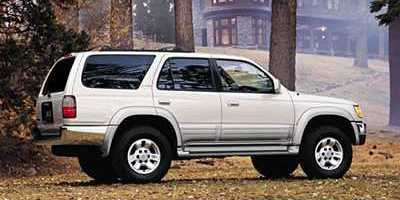
1996 |
|
|






